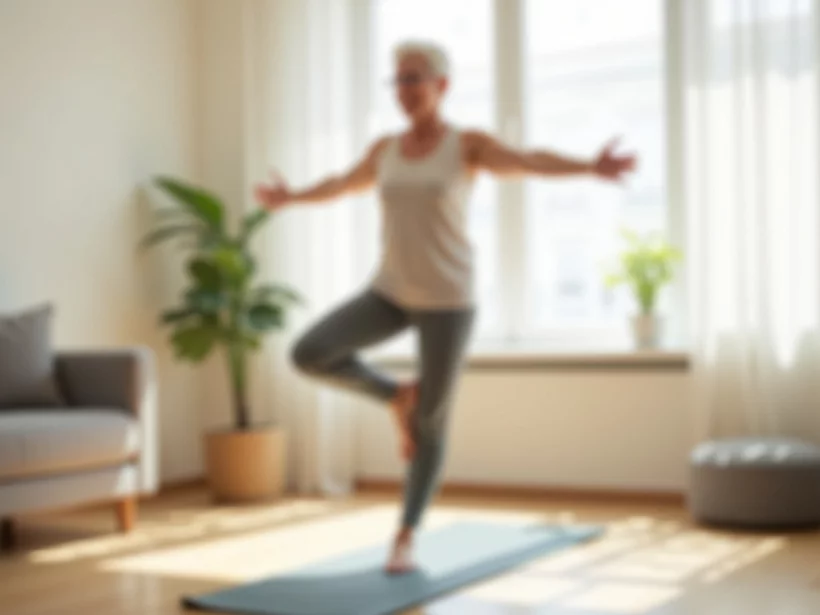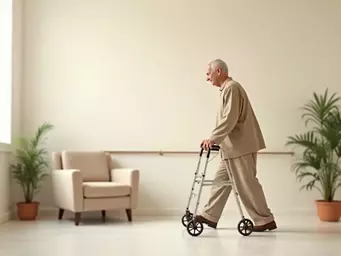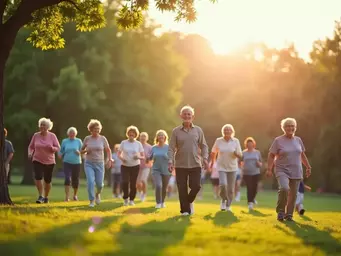Balance Training for Seniors' Safety

As we age, the importance of maintaining balance becomes paramount for safety and independence. With falls being a leading cause of injury in seniors, understanding the factors that contribute to falls and the benefits of balance training is essential. Discover how targeted exercises can empower older adults to stay active and secure!
What You Will Learn
- Recognizing Risk Factors: Understand how muscle weakness, vision changes, medications, and chronic health conditions contribute to falls among seniors.
- Benefits of Balance Training: Learn how targeted training can reduce fall rates, enhance muscle strength, improve posture, and promote overall quality of life.
- Environmental Safety: Identify mobility issues and environmental hazards that can lead to falls, emphasizing the importance of a secure living space.
- Nutrition's Role: Discover how proper nutrition supports muscle strength and coordination, enhancing the effectiveness of balance training.
- Engagement and Consistency: Explore community resources and the importance of a consistent exercise routine to maintain balance improvements over time.
Key Benefits of Balance Training for Seniors
Implementing balance training programs offers numerous advantages that are essential for enhancing the quality of life among seniors. Below is a visual representation of these benefits.
Reducing Fall Rates
Evidence shows that targeted training can significantly lower the risk of falls.
Enhancing Muscle Strength
Specialized exercises help build muscle, improving overall stability.
Improving Posture
Good posture contributes to better balance and reduces the risk of falls.
Promoting Quality of Life
Staying active boosts confidence and independence!
Understanding the Significance of Balance Training in Fall Prevention for the Elderly
As we age, maintaining balance becomes increasingly important for our safety and independence. At Cairns Active Ageing Solutions, we recognize that falls are a major concern for seniors, often leading to serious injuries and diminished quality of life. Through effective balance training, we can help seniors reduce their risk of falls and promote a more active lifestyle. For more insights on staying active, consider the benefits of physical activity for seniors.
Balance training is not just about improving stability; it also addresses various factors that contribute to falls among older adults. Let’s dive into some of these factors and understand how we can mitigate them through targeted exercises and strategies.
Identifying the Risks: Factors Contributing to Falls Among Seniors
Understanding the risks associated with falls is crucial in developing effective prevention strategies. A few common factors that contribute to falls among seniors include:
- Muscle Weakness: This can affect coordination and stability.
- Vision Changes: Poor eyesight can lead to missteps and stumbles.
- Medications: Some medications may cause dizziness or affect balance.
- Chronic Health Conditions: Conditions like arthritis can limit mobility.
By identifying these risks, we can tailor balance training programs that specifically address these issues and help seniors feel more secure on their feet. Learning more about preventing falls for Cairns seniors can provide additional context.
Exploring Muscle Weakness and Coordination Issues
Muscle weakness is one of the leading causes of falls among older adults. When muscles are not strong enough to support the body, it becomes difficult to maintain balance. Additionally, coordination problems can develop, making it harder to perform simple tasks like walking or standing up from a chair. A focus on strength training through balance exercises can significantly improve these issues!
In our programs, we often incorporate exercises that target key muscle groups, helping seniors develop the strength necessary for better balance.
Impact of Vision Changes and Medication on Stability
Changes in vision, such as cataracts or macular degeneration, can severely impact an individual’s ability to navigate their environment safely. Moreover, medications, particularly those affecting the central nervous system, can lead to dizziness or confusion. This can be a double-edged sword when it comes to stability.
It’s essential to review medications with healthcare providers and ensure that visual impairments are addressed, reinforcing the need for regular eye check-ups. At Cairns Active Ageing Solutions, we encourage families to engage in discussions with health professionals about these critical aspects. For more information on creating a safe environment, read about ensuring home safety for seniors.
Chronic Health Conditions and Their Role in Fall Incidents
Chronic health conditions like diabetes, osteoporosis, and heart disease can contribute to falls by affecting a senior's overall strength, coordination, and balance. Additionally, these conditions can lead to fatigue, making it difficult to stay active and engaged.
By understanding these health issues, we can customize exercise plans that not only improve balance but also enhance overall well-being and quality of life!
Understanding Risk Factors and Mobility Issues in the Aging Population
Mobility issues can stem from both physical limitations and environmental factors. Things like uneven surfaces or cluttered pathways present significant risks for falls. Identifying these hazards is a critical step towards improving safety and encouraging active ageing.
At our community workshops, we emphasize environmental safety modifications, helping seniors create a more secure living space that supports their independence and confidence. You can also find valuable tips on embracing active ageing together.
Benefits of Implementing Balance Training Programs
Implementing balance training programs offers a multitude of benefits for seniors. Among the most notable advantages are:
- Reducing Fall Rates: Evidence shows that targeted training can significantly lower the risk of falls.
- Enhancing Muscle Strength: Specialized exercises help build muscle, improving overall stability.
- Improving Posture: Good posture contributes to better balance and reduces the risk of falls.
- Promoting Quality of Life: Staying active boosts confidence and independence!
With a comprehensive balance training program, we’re not just helping seniors stay upright; we're enhancing their overall quality of life and empowering them to live confidently!
Quick Summary
Here's a brief recap of the key points discussed so far:
- Balance training is essential for reducing the risk of falls among seniors.
- Identifying factors such as muscle weakness, vision changes, medications, and chronic health conditions can help tailor effective prevention strategies.
- Implementing targeted balance training programs leads to improved muscle strength, posture, and overall quality of life for older adults.
Frequently Asked Questions About Balance Training for Seniors
Why is balance training important for seniors?
Balance training is crucial for seniors because it significantly reduces the risk of falls, which are a leading cause of injuries. It also enhances muscle strength, improves posture, and boosts overall confidence and independence, contributing to a better quality of life.
What are the main factors that contribute to falls in older adults?
Key factors include muscle weakness, vision changes (e.g., cataracts, macular degeneration), side effects from medications (causing dizziness or confusion), and chronic health conditions like arthritis, diabetes, and heart disease that limit mobility and coordination.
How can environmental hazards increase fall risk?
Environmental hazards like uneven surfaces, cluttered pathways, poor lighting, and lack of handrails can significantly increase the risk of falls. Modifying the living space to remove these hazards is essential for senior safety.
How does nutrition impact balance and fall prevention?
Proper nutrition plays a vital role by supporting muscle strength and coordination. Adequate protein intake is essential for muscle health, calcium-rich foods contribute to bone strength, and consistent hydration helps maintain muscle function. A well-balanced diet enhances the effectiveness of balance training.
What are some ways seniors can engage in balance training and maintain improvements?
Seniors can engage in physical therapy, join community programs at gyms or senior centers, or participate in virtual classes. Long-term maintenance involves consistent practice, setting aside daily time for exercises, involving family or friends, and tracking progress to stay motivated.
Recap of the Importance of Balance Training in Preventing Falls Among Seniors
As we've explored, balance training is not just a set of exercises; it's a lifeline for many seniors. At Cairns Active Ageing Solutions, we see firsthand how effective balance training can be in helping older adults maintain their independence. The benefits extend beyond just reducing falls; they encompass a whole spectrum of health improvements that enhance the quality of life.
To summarize, the key benefits of balance training include:
- Reduced fall rates and injuries through improved stability.
- Increased muscle strength and coordination.
- Enhanced cognitive health and posture.
- Improved functional mobility, leading to a greater overall quality of life.
Encouraging Action: Engaging with Physical Therapy and Community Resources
It's essential to take the next step towards better balance and fall prevention. Engaging with physical therapy can help tailor a program that suits individual needs, especially for seniors who may have specific health concerns. Remember, you don't have to embark on this journey alone; community resources are invaluable!
Here are some practical ways to find local balance training programs:
- Check with your local gym or community center for offerings.
- Contact local hospitals or health clinics for recommendations.
- Explore online resources, including virtual classes tailored for seniors.
Advocating for Long-Term Maintenance of Balance Improvements
Once balance improvements have been made, it's important to maintain them. Regular practice is key! A consistent routine not only improves balance but also builds confidence over time. Encouraging seniors to stay active with ongoing training can lead to sustained benefits.
Incorporating balance exercises into daily routines can be simple. Here are a few ideas:
- Set aside a specific time each day for balance exercises.
- Involve family members or friends to make it a social activity.
- Keep track of progress in a journal to stay motivated.
Importance of Nutrition and Health Education in Supporting Balance Training
Finally, let’s not overlook the role of nutrition in supporting balance training. A well-balanced diet can significantly influence muscle strength and coordination, making it easier to engage in physical activities. At Cairns Active Ageing Solutions, we emphasize the connection between nutrition and overall health in our discussions.
Key nutritional tips include:
- Ensure adequate protein intake to support muscle health.
- Incorporate calcium-rich foods for bone strength.
- Stay hydrated to maintain muscle function and coordination.
Engaging in nutritional education alongside balance training can create a holistic approach to health and well-being, ensuring that seniors not only strengthen their bodies but also nourish them for a vibrant future.
Recap of Key Points
Here is a quick recap of the important points discussed in the article:
- Identify Risk Factors: Understand common risk factors contributing to falls, such as muscle weakness, vision changes, medications, and chronic health conditions.
- Engage in Balance Training: Implement balance training programs that focus on enhancing muscle strength, coordination, and posture to reduce fall risk.
- Regular Health Reviews: Schedule regular check-ups with healthcare providers to review medications and address any vision impairments.
- Modify the Environment: Assess and modify living spaces to eliminate hazards that could lead to falls.
- Nutrition Matters: Maintain a balanced diet rich in protein and calcium to support muscle and bone health.
- Stay Active: Encourage ongoing participation in balance exercises and physical activities to sustain improvements and boost confidence.







